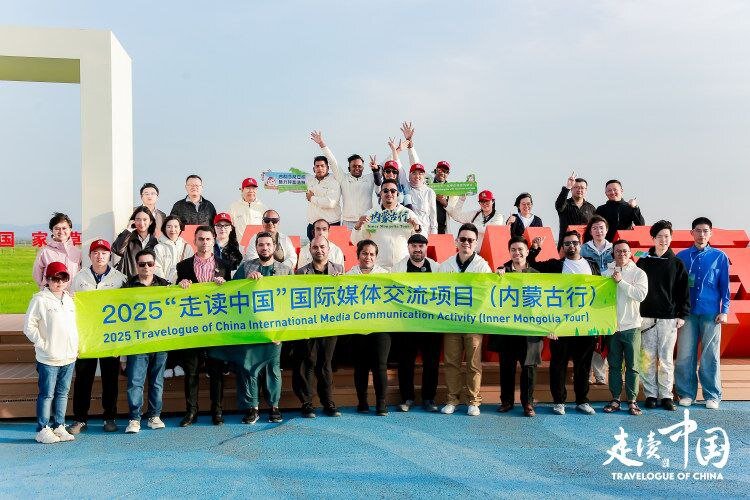Exploring Inner Mongolia’s Cutting-Edge Innovations: From VR Headsets to Autonomous Rides!
During the second day of the “Travelogue of China” tour, foreign reporters explored the vibrant developments in Inner Mongolia, an autonomous region that showcases the blend of modern innovation and rich cultural heritage. This initiative, organized by the China Public Diplomacy Association (CPDA) and Global Times Online, provided a unique opportunity to witness how Inner Mongolia is shaping its future while honoring its traditions.
The journey began at the Yungu Exploration Port, situated in the Data Town of Horinger New Area. This state-of-the-art digital exhibition center enhances the cultural tourism experience by providing high-quality digital content. As an Iranian journalist representing the Tehran Times, I had the chance to engage with groundbreaking VR technology at the port. The immersive experience combined stunning visuals with intuitive interactivity, creating a virtual reality environment that felt astonishingly real. This was more than just a technological showcase; it was a glimpse into the future of digital exploration.
Hohhot’s Data Town stands out as a beacon of innovation, and the Yungu Exploration Port exemplifies China’s ambitious technological advancements. It is a must-visit for anyone interested in the future of technology and its influence on culture.
Next on the itinerary was the Inner Mongolia Data Exchange Center, the region’s only government-approved data trading platform. This center plays a pivotal role in supporting the data market and digital economy through various services, including:
- Data registration
- Data trading
- Automated matching
- Computing resource transactions
By integrating regional and industry-specific data, the center aims to expand product types, trading domains, and partnerships, thus boosting market growth. Its mission is to create a secure, efficient, and compliant data exchange hub that serves Inner Mongolia and beyond.
The tour also featured a visit to the Hohhot International Sculpture Park, which beautifully expresses the essence of “Northern Frontier Culture.” This park harmoniously combines architecture with nature, adapting its design to the natural terrain to create a seamless bond between the built environment and the landscape.
Spanning 37,000 square meters, the park is adorned with lush greenery, where grasses cover rooftops and grounds, allowing the structures to blend effortlessly into the environment. The design features sloping roofs that stretch north and south from the central axis, evoking the silhouette of an eagle in mid-flight, symbolizing the region’s dynamic spirit.
Next, we were warmly welcomed at the M-Grass Group, a leader in ecological restoration. The company has developed a comprehensive system for conserving, breeding, and promoting indigenous plant species through its Inner Mongolia Sub-bank of China’s National Germplasm Resource Bank. Key highlights include:
- Safeguarding over 2,200 plant species and 60,000 germplasm accessions
- Maintaining 150,000 biological specimens and 1.5 million soil samples
- Leading the industry with 513 established standards
- Filing 968 patents, ranking sixth globally in grass seed technology
M-Grass operates China’s first national intellectual property center for the grass industry and has developed 295 native plant varieties, including 105 proprietary species. This initiative supports ecological restoration, forage development, traditional Chinese medicine, and specialty crops, showcasing the company’s commitment to sustainable land management.
Through its extensive production base of 18,700 hectares, M-Grass offers customized restoration solutions, featuring specialized seed packages, innovative seed ropes, and soil enhancement technologies. These scientifically developed methods have successfully restored 2.2 million hectares of degraded grasslands, mining sites, deserts, and saline-alkali lands across China.
The final stop for the foreign reporters was the Chilechuan Grassland, located in Yematu Village just outside of Hohhot. This expanse of pristine wilderness is often referred to as the “Ten-Thousand-Mu Grassland” and serves as the beloved “Back Garden” of Hohhot, known as the “Blue City.” The picturesque landscape was also the site of Inner Mongolia’s 70th anniversary celebrations.
Visitors to Chilechuan are greeted with endless emerald pastures and the architectural marvel of the Hohhotara Conference Center, located within China’s largest traditional yurt. This unique combination of natural beauty and cultural significance makes Chilechuan an ideal retreat for those seeking an authentic grassland experience.
The tour concluded on a high note as journalists experienced the future firsthand by riding in cutting-edge driverless vehicles along the scenic roads of the Chilechuan Grassland. This thrilling journey not only highlighted China’s technological advancements but also illustrated how innovation and tradition can coexist, enhancing rather than erasing cultural heritage.
The recent visit by international journalists to Inner Mongolia marks a significant milestone in the “Travelogue of China” initiative. Over the past two years, this program has engaged 130 journalists from 80 countries across five continents, allowing them to explore 17 different regions of China.
Arriving in Hohhot on Monday, we began our five-day journey through Inner Mongolia’s breathtaking landscapes and vibrant culture. By Tuesday night, our adventure led us to Ulanqab, where even more discoveries awaited.






